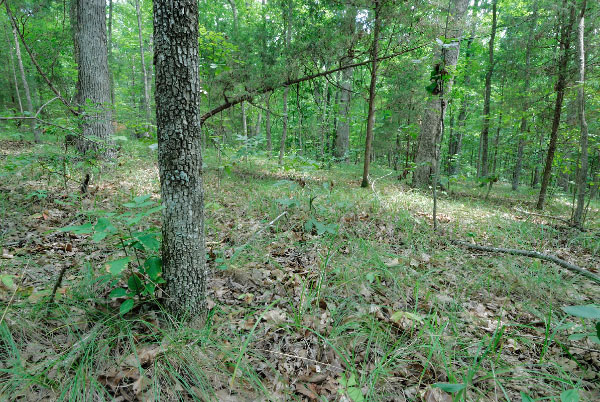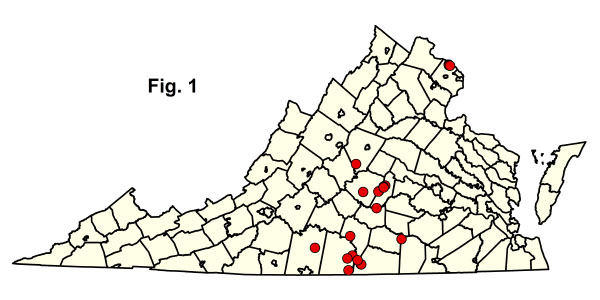

Virginia Department of Conservation and RecreationAn official website of the Commonwealth of Virginia Here's how you knowAn official websiteHere's how you know

Virginia Department of Conservation and RecreationAn official website of the Commonwealth of Virginia Here's how you knowAn official websiteHere's how you know
 Department of Conservation and Recreation
Department of Conservation and Recreation
 Table of Contents
Table of ContentsPiedmont Hardpan Forests
This ecological group contains a group of oak-hickory forests that occupy gentle to flat Piedmont uplands with impermeable clay subsoils. On high bedrock terraces of the Potomac Gorge in northern Virginia and occasionally elsewhere, flat-lying bedrock underlying shallow soil acts as a surrogate "hardpan" and supports similar vegetation. Piedmont Hardpan Forests occur from Virginia south to Georgia. Sites are usually underlain either by mafic rocks such as diabase or by acidic slates. Surficial soils are silt or clay loams, with an abrupt transition to heavy, plastic clay hardpans at depths of 23 to 38 cm (9 to 15 in). These shrink-swell clay soils pond water for brief or, at a few sites, prolonged periods during rainy weather, but tend to be very hard and dry during significant portions of the growing season. Post oak (Quercus stellata) is the most typical overstory tree, growing in nearly pure stands or in variable mixtures with pignut hickory (Carya glabra), Carolina shagbark hickory (Carya carolinae-septentrionalis, only in Charlotte, Halifax, and Pittsylvania counties), white oak (Quercus alba), blackjack oak (Quercus marilandica var. marilandica), Virginia pine (Pinus virginiana), and white ash (Fraxinus americana). Virginia pine increases following cutting and may dominate on heavily disturbed, clear-cut sites. Winged elm (Ulmus alata), sweetgum (Liquidambar styraciflua), and eastern red cedar (Juniperus virginiana) are characteristic understory trees. Shrubs include eastern redbud (Cercis canadensis var. canadensis), black haw (Viburnum prunifolium), fringetree (Chionanthus virginicus), and blueberries (Vaccinium spp.). In closed stands, there is often little herbaceous growth, while more open stands support large patches of xerophytic graminoids such as poverty oatgrass (Danthonia spicata), eastern needlegrass (Piptochaetium avenaceum), and little-headed nutrush (Scleria oligantha).
Stands located on ancient, never-flooded stream terraces on which water ponds for longer periods contain peculiar mixtures of upland and wetland species, but their hydrological status is problematic and they are treated here as communities of the Terrestrial System. In these periodically wet variants, species such as willow oak (Quercus phellos), sweetgum (Liquidambar styraciflua), deciduous holly (Ilex decidua), hairy highbush blueberry (Vaccinium fuscatum), St. Peter's-wort (Hypericum crux-andriae), and beaksedges (Rhynchospora spp.) are intermingled with the xerophytic species listed above.
Piedmont hardpan forests are scattered throughout the Piedmont in specialized soil environments and are considered uncommon to rare in Virginia. The Northern Hardpan Basic Oak - Hickory Forest (CEGL006216), currently treated in the Basic Oak - Hickory Forests ECG, could also be included in this group, but grows on substrates with somewhat variable subsoil characteristics.
Reference: Fleming (2002a), Fleming (2007).
Click here for more photos of this ecological community group.
 © DCR-DNH, Gary P. Fleming.
© DCR-DNH, Gary P. Fleming.

 Download a spreadsheet of compositional summary statistics (Excel) for each of the community types listed below.
Download a spreadsheet of compositional summary statistics (Excel) for each of the community types listed below.

